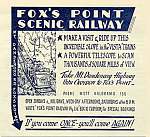1950 to PRESENT DAY
Early 1950s. Land
which would subsequently be used for the Railway had been purchased by a
Mr Neil Foxcroft. This extended from the Tourist
Rd to Scenic Crescent at the top of the gully. As discussed elsewhere, Mr Foxcroft had built a house on this land. It consisted
of Lot 12, part of Crown Allotment 76B.
1953 to 1961. The
Railway was in operation
1962. Much of the railway land was destroyed by
serious bushfires
1965. Railway dismantled
1970. Mr Dan Cerchi purchased Lots 11 12 and 13. Lot 12 was the
former Railway Land. After purchase, remnants of the railway had been discovered by
Dan, including the car engine and a water tank.
1971. The road was realigned,
with a crossover and kerbing built at the former railway site.
c1972.
Serious slippages of land occurred on Dan's holdings, with the main road becoming blocked.
Repairs were made by the Government, but further slippages required major restoration
of the road - additional drainage was built into the hillside. Dan recalls
that at one stage there was concern that part of the road would break away and slide down the hill towards Mt Evelyn.
It
was believed that these landslides were the result of the land being cleared for the railway
infrastructure.
1974 The Government purchased sections of Dan's
land and that of neighbouring owners. Financial compensation was made. This land
then reverted to Government ownership, and in 1987 was integrated into the newly proclaimed National Park.
1987.The
Dandenong Ranges National Park was proclaimed.
1997. Extensions
to the NP were announced.

